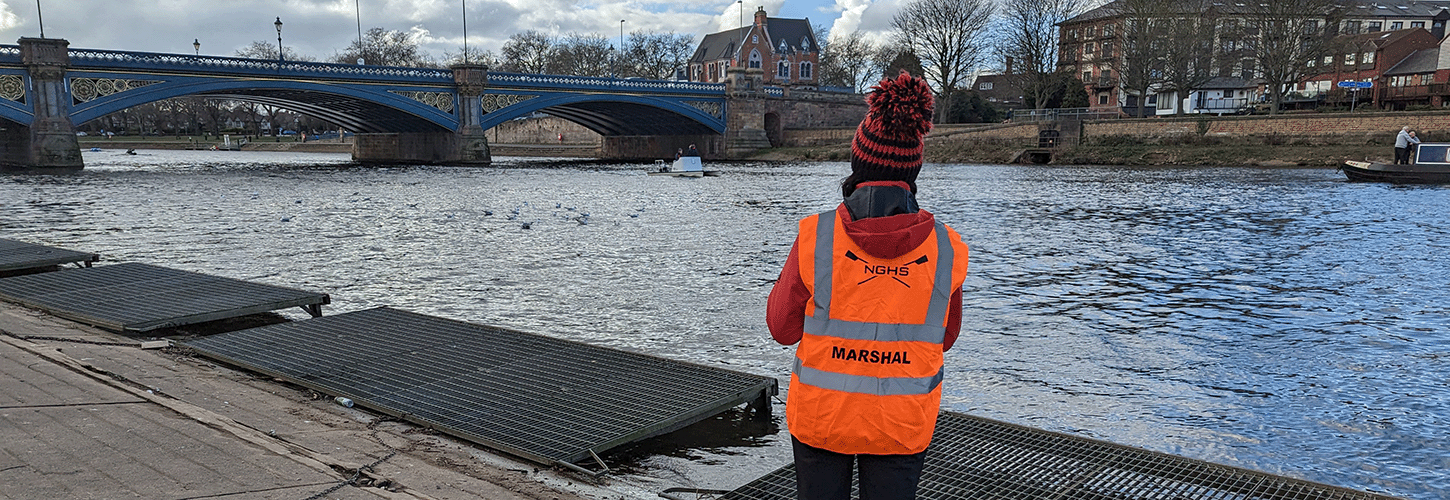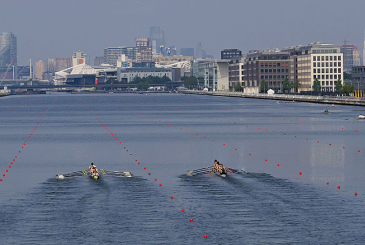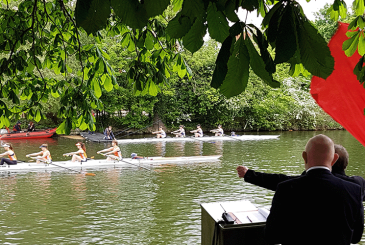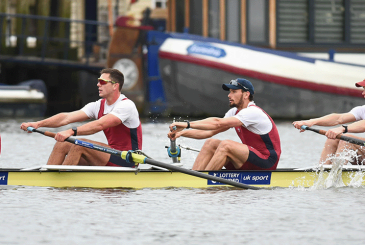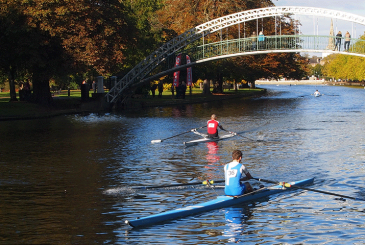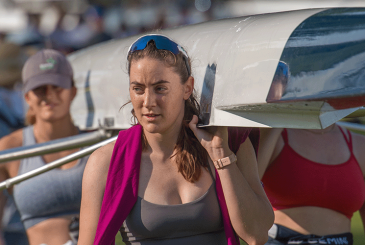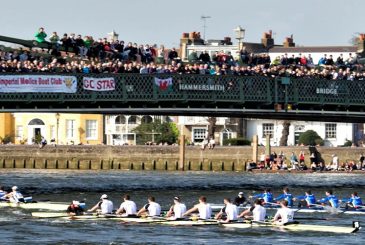The format is simple – racing one at a time over a set distance against the clock – but a great deal of planning still goes into running a head race. Zoe Gullen looks into some of the important details.
Plotting the best course
While heads are traditionally long-distance races to test endurance, the longest possible course may not always be the best option; modifying the course can help with logistics and better suit some competitors.
For example, Huntingdon Head slightly shortened their course on the Great Ouse, so that the race stops before the landing stage. This allows crews to paddle straight in after their race without turning.
Huntingdon also have a 2km mini head, with a slightly reduced entry fee, for J11s to J14s. Similarly, the final division of the Isis Sculls runs over a shorter, straighter course, with events for younger and less experienced competitors as well as adaptive athletes.
Events
The head season often follows a rhythm, starting with small boats in the autumn through to eights in the winter and early spring. However, many clubs welcome the opportunity to race all boat classes all year, especially those with small squads, or small-boat specialists who want to test their winter training in spring racing.
Offering a wide variety of boat classes and categories means clubs can attend en masse, with a broad spectrum of members of all ages getting to race, while separating categories into divisions allows for boat-sharing between crews and the opportunity to race more than once.
Boating and marshalling
Getting all crews on the water safely and on time is a significant challenge. Publishing boating times helps things run smoothly. Monmouth and Worcester go a step further and require crews to boat in number order.
At Trafford Head, competitors can hand over spare kit at the start
When you’re deciding the capacity of divisions, make sure you consider how many crews can be marshalled safely and, as far as possible, not be on the water for too long. This is particularly during the coldest months. To help with keeping warm during marshalling, at Trafford Head, run in February, competitors can hand over spare kit (in labelled bags picked up at registration) to marshals at the start.
Competitors’ instructions and numbers
The competitor’s instructions may be a crew’s introduction to the river on which they will race, so it is important that they are as clear as possible. The instructions for Teddington and Trent Heads are just two examples that include photos of the various bridges along the course, marking which arch racing crews need to go through.
To save printing, a website link or QR code can take competitors to the instructions on their phones, rather than including printed copies in race packs. As not everyone can read a pdf on their phone, publish the instructions directly on a web page. Some races hold an in-person safety briefing or have a mandatory briefing video on their website. Trafford also includes video instructions for how to overtake safely on the narrow Bridgewater canal.
Number-suppliers will print the crew and event name on paper numbers.
Sorting numbers into envelopes by club helps to save time at registration, and several number-suppliers will print the crew and event name on paper numbers.
Ensure a plentiful supply of safety pins: they are literally tiny, but prevent big headaches for the timing teams by keeping numbers firmly in place. To avoid the tedium of counting out pins, one enterprising race organiser weighs quantities for each club using electronic kitchen scales.
Timing is everything
Some larger competitions have set the bar high with commercial timing teams producing live times and even livestreaming. This can be a big ask for smaller heads. All that’s essential is that you ensure there is a robust system and results are correct. While there is always pressure to publish results as quickly as possible, accuracy cannot be sacrificed for speed.
Accuracy cannot be sacrificed for speed
No matter how sophisticated a timing system, a separate back-up is always a good idea. At the Oarsport Junior Sculling Head, a manual team uses stopwatches alongside the electronic timing system. After of each division, this team sends photos of their timing sheets to the results team via WhatsApp, to be printed out and typed up.
Hampton Head’s manual timing team uses different-coloured paper for each location, so the relevant sheets can be found quickly when verifying the computer times. Scribes are equipped with pencils rather than pens, as they won’t run out of ink.
Off the water
As part of the pre-race communications, make sure visiting clubs know what to expect in terms of facilities. In particular, trailer drivers will want to know about any special arrangements such as on-site one-way systems.
A map of parking locations is helpful, with postcodes for satnavs or What Three Words, and also public transport options.
Let competitors know what will be on offer, and when
Food is always an important consideration for a long day of racing, so again let competitors know what will be on offer, and when. Refreshments are a good fundraising boost for the organising club, as well as adding to the social occasion. At the Head of the Mersey, Warrington fire up what is billed as ‘the best BBQ in the north-west’, offering breakfast from 7am and running through the day.
Drinks are obviously essential, whether at the club bar or tea table, or just access to water. At Trafford, competitors are reminded to bring their own water bottles, which can be filled from jugs available at race control.
Prizes
A prize-giving is a great way to bring everyone together to celebrate, socialise and round off a successful day. However, some clubs, especially those with a long distance to travel, may want to head home, so there should also be the option to award prizes at the conclusion of each division.
Well-considered prizes, especially those that commemorate the particular year and event, are always popular. Thoughtful provision for smaller categories is appreciated too. The Isis Sculls awards medals to categories with four or more competitors, and pennants if three or fewer, so all winners receive a memento of the day.
Champs Eights Head in Cambridge has a number of special awards including prizes for best cox and best start!
Extra prizes add another dimension, from perpetual trophies such as the storied Weybridge Silver Sculls to Runcorn’s Victor Ludorum for university crews. In addition to tankards for category winners and trophies for the fastest overall crews, Champs Eights Head in Cambridge has a number of special awards including prizes for best cox and best start!
Preparing for the worst – cancellations
Good communication is key, especially in the run-up to the race so competitors are aware of the situation and any key metrics – such as river levels or flag status – that need to be taken into consideration. A timetable of decision-making is also helpful, with defined communication channels, such as Twitter/X and the race website, for updates.
Valuing volunteers
As always, volunteers are at the heart of a successful competition – it simply would not happen without them.
Briefings can be done online ahead of the race to reduce time pressure on the day, as well as sending out detailed information sheets for each role, the location of volunteering stations and how to get there, such as by organising car-shares to get timing teams and all of their equipment to their timing points.
Volunteers appreciate being welcomed with food and drink before racing gets under way
Race day itself can be very long, so volunteers appreciate being welcomed with food and drink before racing gets under way, and having refreshments available whenever they are off shift – which may not just be between divisions. At the Veteran Fours Head, bags and cups are supplied for volunteers to fill with supplies to take with them for the race.
Small ‘thank you’ gifts are always welcome, but do consider sustainability. ‘Consumable’ items such as large bars of chocolate go down well.
Measuring success
The measures of success are very simple: a well-subscribed entry; volunteers willing to give up their time to help; safe, well-marshalled racing; accurate times produced promptly; positive feedback and a willingness to implement changes – and, above all, clubs coming back year after year.
Organising a regatta?
Check out Zoe’s article on What makes a successful regatta?


